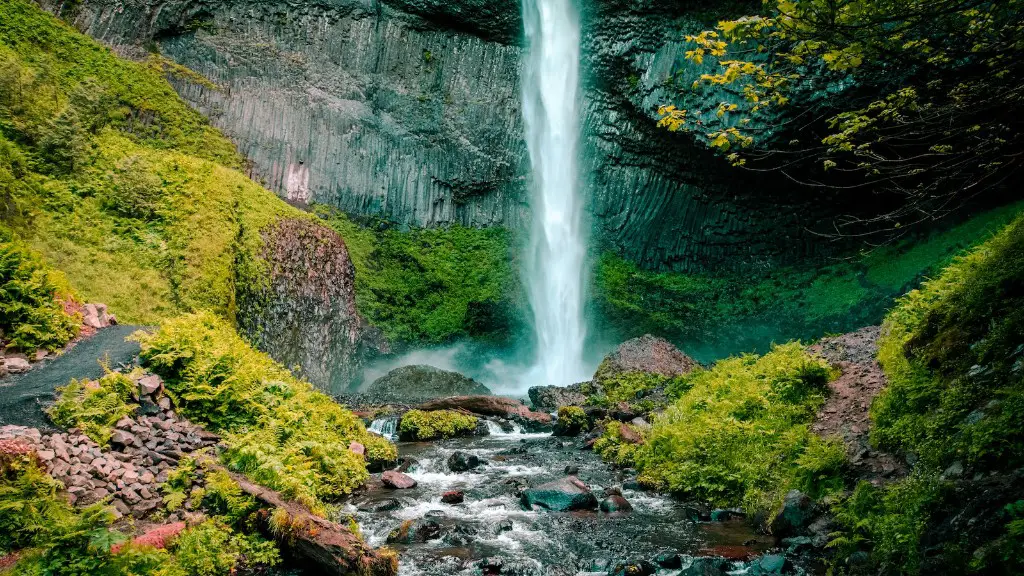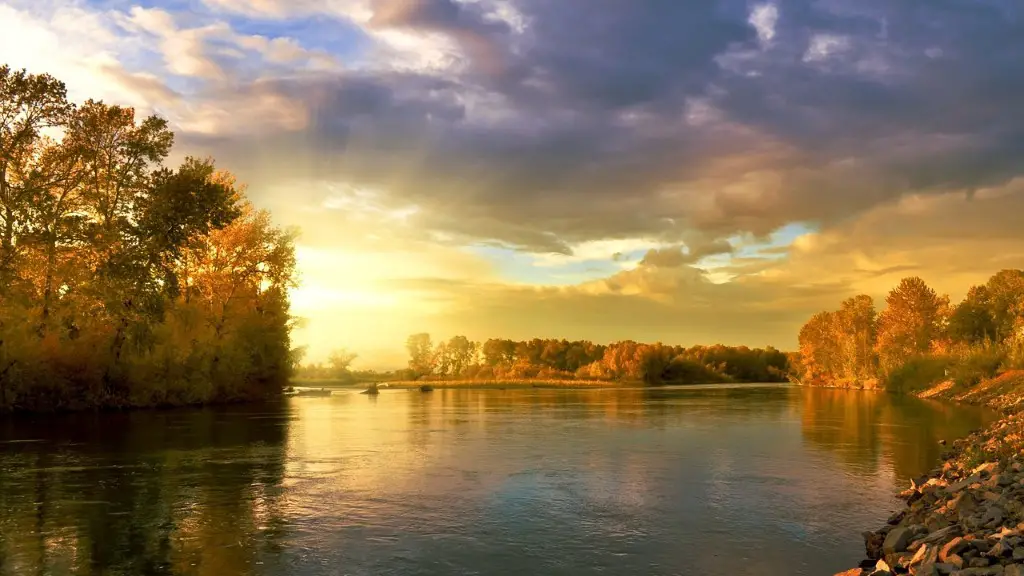The Mississippi River is one of the premier waterways in the United States and perhaps even the world. It has long been a crucial element in the early growth of the US and continues to play an important role in the lives of hundreds of millions of people in the United States today. So, how far does the Mississippi River actually go?
The headwaters of the Mississippi River are located in Lake Itasca, Minnesota, 1,475 feet above sea level. From there, the Mississippi River proper travels a distance of 2,350 miles all the way to its mouth at the Gulf of Mexico. This lengthy journey takes the river through 10 major states, including Minnesota, Wisconsin, Iowa, Missouri, Arkansas, Tennessee, Kentucky, Mississippi, Louisiana and even portions of Illinois. Along this route, the Mississippi River crosses through a vast array of terrain and climates, from lush woodlands to steamy swamplands. It is also joined at various points by the Missouri, Ohio, Illinois and Arkansas Rivers.
As the Mississippi River meanders through 10 states and various ecosystems, it makes a mighty impact on the people and environment living in these areas. The role of the Mississippi River in American history is undeniable, having played a key role in the development of agriculture and commerce, as well as being a major recreational fishing hub. Currently, the river transports roughly 500 million tons of cargo every year. It has also spurred the development of metropolises like Saint Louis, Memphis, New Orleans and Minneapolis–Saint Paul. In addition, the Mississippi River basin provides 45% of the wetlands in the lower 48 states, making it an important part of the US’ natural landscape.
The Mississippi River is also a major source of water for homes, businesses, farms and power plants. Over 31 million people in the US get their water from the Mississippi River, making it a lifeline for communities across the country. As such, it is critically important that the encompassing watershed and its resources are managed responsibly. This is reflected in the various water management initiatives undertaken by the governments of the 10 states along the Mississippi River. These measures are designed to ensure that local communities and ecosystems both enjoy the full benefits of this legendary river.
Flooding
Due to the various climates and terrain that the Mississippi River traverses, it is also prone to occasional flooding. This natural phenomenon is largely caused by the runoff from heavy rains and can become an individual or community-wide disaster if public safety protocols and policies are not followed. Typically, the US Army Corps of Engineers works to manage the level of the river, including the direction of its flow. As such, the Corps of Engineers actively monitors the river’s waterline levels and builds flood levees and embankments to help minimize potential flooding during storm events.
However, flooding continues to pose a major threat to communities living alongside the Mississippi River. For example, in the 18 months between 2004 and 2005, 44 of the lower 48 states experienced flooding, with 73% of these events attributed to the Mississippi River. The economic impacts of this flooding were impacting for some communities, with one estimate calculating an economic loss of more than $4 billion! To help keep citizens better informed of potential flooding, the US authorities have invested heavily in a number of flood warning systems, which provide critical real-time information to help those who might put at risk by the flooding.
Wildlife
The Mississippi River system may be best known for its economic impacts, but it also plays a key role in supporting a range of wildlife. For example, the river’s rich aquatic and terrestrial habitats provide perfect conditions for numerous native species, including fish, mollusks, turtles, muskrats, snakes and amphibians. This biodiversity provides crucial opportunities for recreation and research related to the area and its animal inhabitants.
In terms of birds, the Mississippi River is also a vital flyway for numerous waterfowl, as well as providing services such as nesting sites and food sources to numerous species of migratory birds. In fact, the Bald Eagle – the national bird of the United States – has made the Mississippi River its main habitat for much of its life cycle. This majestic animal can often be seen flying alongside the river, passing through multiple states and countless habitats and in the winter, fishermen often find hundreds of the them perched along the icy banks of the river.
Unfortunately, the Mississippi River system is not immune to the impacts of environmental degradation. Much of the river has been altered throughout its long history, causing massive changes to wildlife and natural habitats. Despite ongoing efforts to remediate and improve the Mississippi River’s environment, land and water pollution remain a significant problem in many regions of the river.
Recreation
As well as being a crucial economic and environmental necessity, the Mississippi River has also become an important recreational destination for millions of visitors every year. Numerous activities, such as boating, fishing, swimming and camping, draw huge crowds to the river from early spring until late autumn. Some of the most popular recreation sites can be found in the Mississippi River Valley and the surrounding states, with many towns offering majestic landscapes and some of the finest river-based activities you’ll find.
The Mississippi River is also home to numerous wildlife watching opportunities. The many bird species of the Mississippi flyway make it a great destination for backyard birders, while the river’s many wild species provide a unique chance to get up-close and personal with these animals. Furthermore, the numerous preserves and parks that dot the shores of the Mississippi offer visitors an opportunity to explore the diverse habitats of the river’s multiple ecosystems.
The Mississippi River is also ideal for barge and boat cruising. The Famous Voices of the Mississippi offers numerous historical cruises along the length of the river, while larger boats offer longer trips on stretches of the river. Plus, many of the tour boats provide dinner cruises, with meals cooked and served on board. Combined with the rustic beauty of the river, such a cruise is one of the most popular recreation activities that the Mississippi River has to offer.
Education
The Mississippi River has long been used as a classroom for students of all ages. Numerous institutions at both the state and local level offer educational programs for those interested in learning about the river’s ecology, geology and history. These programs offer invaluable insight into how the river helps to shape American social, economic and political life.
At the same time, the Mississippi River has also become an important laboratory for environmental research. Due to its vast size and impressive array of biodiversity, researchers have long relied on the Mississippi River to help deepen their understanding of the nation’s ecology. This research is made possible in large part due to the generous access that researchers have to the river and its resources.
The Mississippi River is also used as a teaching tool in many schools throughout the US. Numerous schools have incorporated curriculum related to the Mississippi River into their courses. Coming to understand the river’s many contributions to the region helps to give young students a greater appreciation for their home, as well as helping to develop a connection to the American natural wilderness.
Conservation
Recognizing the vital role that the Mississippi River plays for millions of people living around the river, various conservation organizations have sprung up to help protect and manage the area. These organizations work diligently to protect the river from erosion, pollution and development, and also help to facilitate recreational opportunities for visitors.
Various states in the Mississippi River region have enacted measures to help protect and preserve this vital river ecosystem. For example, several states have created aquatic reserves and waterside sanctuaries in an effort to help mitigate the impacts of development. These conservation efforts have helped to preserve the historic beauty of the Mississippi River, while also helping to protect communities and animals living around the river.
In addition to state-level efforts, there have been a number of federal initiatives as well. The US Army Corps of Engineers has long been a leader in this category, taking on large-scale projects to help protect the river and its waterways. Such projects have included bridge repairs, channel repairs and restoration, to help ensure that the Mississippi River remains a healthy, functioning waterway for many generations to come.




